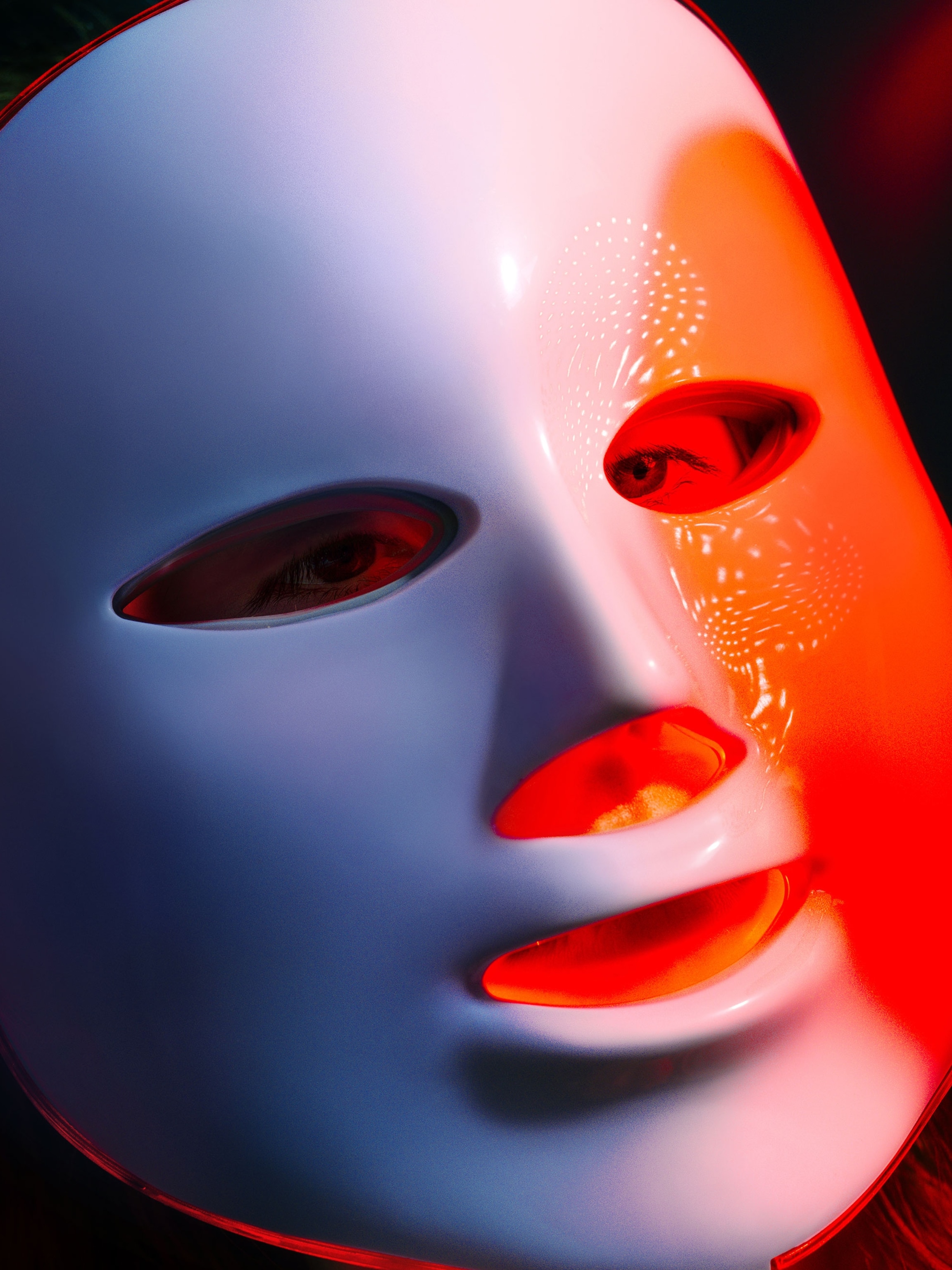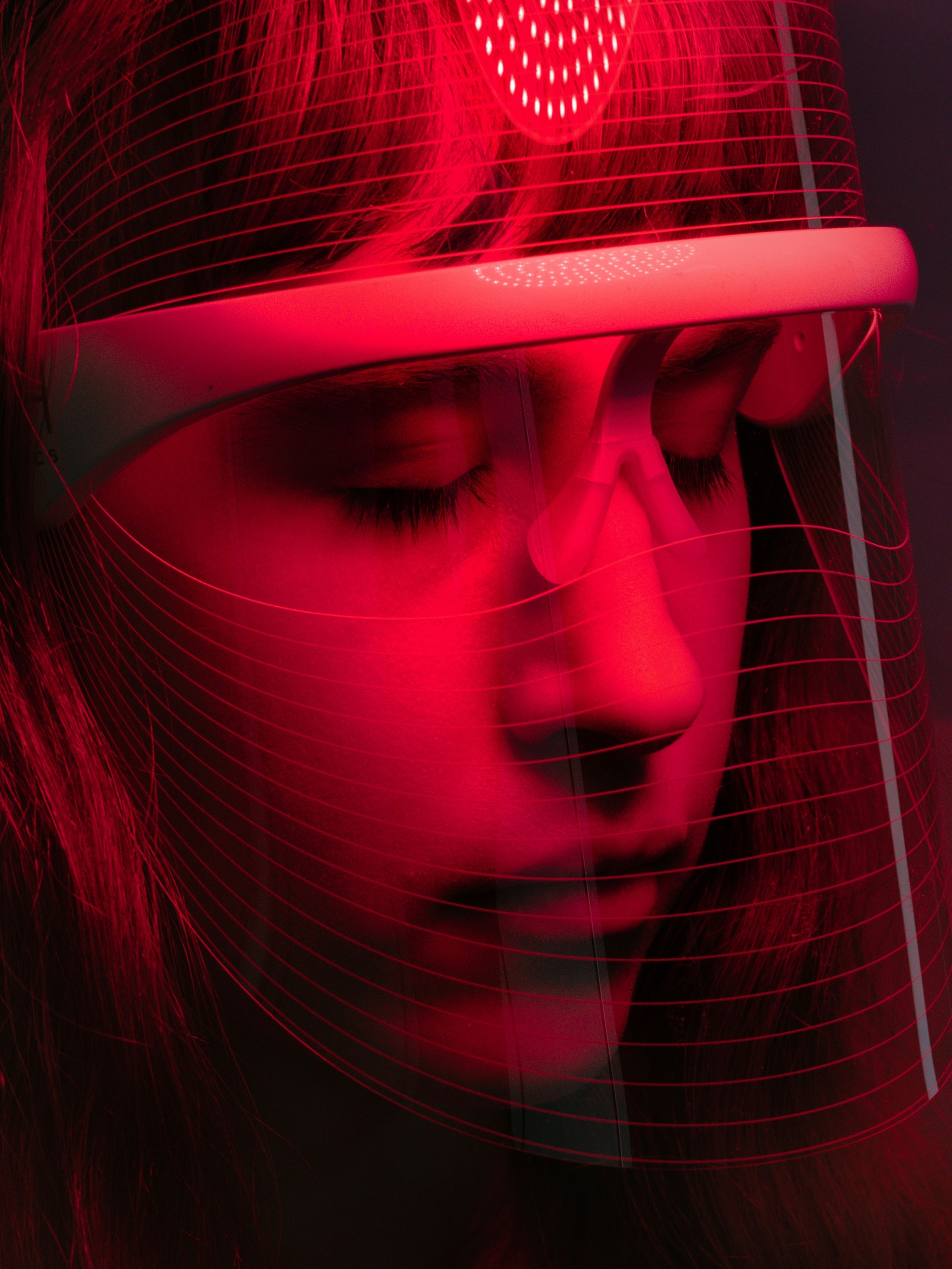LED light therapy for skin is trendy—but does it work?
Dermatologists explain the science behind the wildly popular treatment, which is now available at home—for a steep price.

In the mid-1960s, a Hungarian physician named Endre Mester shined a low-power laser on the shaved skin of a mouse. Though he was testing for impacts on tumor growth, he observed an unexpected side effect—the red light seemed to stimulate hair regrowth and, in later studies, wound healing.
Sixty years later, this accidental discovery has found its way into a booming market for clinical procedures and at-home devices using light-emitting diodes (LEDs).
Also possible with cold lasers, "low level" or "low power" light therapy requires a certain power level (measured in milliwatts per centimeter) to be effective, without the damaging heat of high-powered lights. From face and full-body masks to portable wands, low-level light therapy products promise all sorts of anti-aging, rejuvenating, and wound-healing benefits.
“There’s a lot of hype in the industry,” says Daniel Barolet, a dermatological laser therapy researcher and clinician, and an adjunct professor at McGill University.
But are these devices—which can cost hundreds, even thousands of dollars—worth the price? Experts discuss the benefits and limitations of light therapy, and what consumers should know before making the investment.
The science of light therapy
In the decades since Mester’s groundbreaking mice trials, research and development of phototherapy has taken off—with promising results.
Today, LED light therapy, or “photobiomodulation” (PBM) as it’s more accurately known, uses gentle, low-level light within the visible spectrum—typically blue, red, or near-infrared—to stimulate natural physiological processes. Or, as Barolet says, PBM just means “using light to give our cells a little nudge in the right direction.”
For much of human history, we would have gotten these benefits directly from the sun—but now we’re spending more time inside, with often cool-toned indoor lighting.
“When we're using photobiomodulation, we just cut the bad UV rays. We're just using the healing stuff,” Barolet says. “It’s biomimicking, but you harness what’s good for your skin, and you delete what’s not good for your skin.”

While the exact mechanisms are not yet fully understood, PBM therapy has been shown to produce a range of positive effects. Blue light, for instance, can be used to treat acne and may mitigate other skin disorders by reducing inflammation. When blue light is absorbed by the skin, it activates the production of toxic free radicals which, over the course of several days, kill off the acne-causing P. acnes bacteria.
Glynis Ablon, a dermatologist and associate clinical professor at UCLA, says she’s seen dramatic effects in her patients undergoing blue light therapy. “What they'll notice, just from these LEDs alone, is that their acne gets better, that the level of inflammatory lesions reduces, that their overall skin just starts to look better.”
Red and near-infrared light, on the other hand, have longer wavelengths that can target the skin cells or travel deeper into the body. When light in this range penetrates the cells, Barolet says, it “kicks off a chain reaction” in the mitochondria. This metabolic process produces several important molecules, including ATP and nitric oxide, that are critical for basic bodily functions like energy production and healthy blood flow.
The application of red and near-infrared light has a domino effect, stimulating collagen production and blood circulation. On a surface level, this can speed healing of wounds, such as burns or ulcers, and even reduce signs of aging, like wrinkles and brown spots.
While the skin is the largest and most visible organ in the body, all cells theoretically can enjoy a boost from red or near-infrared light therapy.
Generally speaking, the tissues that will improve the most are those in a state of depletion or disorder—such as sunburnt skin—according to Alexander Wunsch, a physician and photobiology expert. Of course, light therapy isn’t a panacea for treating skin or any other conditions.
“There is real science to it and it does work clinically,” says Zakia Rahman, a clinical professor of dermatology at the Stanford School of Medicine, “but it’s not going to have the level of dramatic effect that more aggressive treatments in a medical setting would have.”
Still, LEDs have distinct benefits—they’re non-invasive, pain-free, and essentially harmless. Prolonged exposure to blue light, which is near the UV spectrum, may cause skin damage, aging or irritation, but long-term research is still limited. With red and near-infrared, the only potential concerns are for those with sun allergies or highly sensitive eyes, according to Barolet.
“Think of photobiomodulation like your morning cup of coffee…but with light,” Barolet says. “It's like a wake-up call that gets all those tiny cellular processes up and running, helping the body to repair, rejuvenate, and energize itself.”
How should you pick your LED device?
Clinics around the world offer PBM therapy for all sorts of cosmetic and medical purposes. Office devices are generally more powerful, producing better and faster results. But for those who want to do their treatment at home, there’s a market full of options.
When it comes to choosing an LED device, experts agree that the most meaningful factor to consider is the output intensity.
“There’s a lot of scams out there…most of the time, energies are very, very low,” Ablon says. For red light, she looks for devices that emit 105 milliwatts per centimeter, but for blue light, the intensity can be lower. “If it’s somewhere in that 40 range, I’m ok, but if it ends up being 10, it’s probably not doing anything.”
Barolet also warns consumers to avoid devices that promote “a rainbow” of lights, such as green, yellow, and purple. When it comes to health, he says, the only wavelengths proven to be effective are red, near-infrared, and blue.


It’s important to note that not all LED products on the market have been greenlit by the FDA. Wunsch advises consumers to look for 510(k) Clearance, “which gives you at least the information that this device has been evaluated”—though not tested—by the FDA for safety and effectiveness.
Barolet notes that, while the research supporting light therapy is robust, scientists are still perfecting their “recipe”—the ideal wavelengths, dosage, intensity, and proximity—for different health goals. In some cases, LED therapy works best in concert with other interventions, like pairing red light treatment with anti-aging cream, he says. While not a replacement for products like sunscreen or prescription retinoids, Rahman says that LEDs “can work well in your entire skin regimen.”
Ultimately, whether undergoing a clinical procedure or using at-home masks, experts advise people to stay the course of the treatment and not expect immediate results. While wound healing can happen faster, Wunsch says, the effects on healthy, normally aging skin can be slow and cumulative. “You have to invest in the compliance in the first phase, and you will get your rewards in five or ten years.”
You May Also Like
Go Further
Animals
- This fungus turns cicadas into zombies who procreate—then dieThis fungus turns cicadas into zombies who procreate—then die
- How can we protect grizzlies from their biggest threat—trains?How can we protect grizzlies from their biggest threat—trains?
- This ‘saber-toothed’ salmon wasn’t quite what we thoughtThis ‘saber-toothed’ salmon wasn’t quite what we thought
- Why this rhino-zebra friendship makes perfect senseWhy this rhino-zebra friendship makes perfect sense
- When did bioluminescence evolve? It’s older than we thought.When did bioluminescence evolve? It’s older than we thought.
Environment
- Are the Great Lakes the key to solving America’s emissions conundrum?Are the Great Lakes the key to solving America’s emissions conundrum?
- The world’s historic sites face climate change. Can Petra lead the way?The world’s historic sites face climate change. Can Petra lead the way?
- This pristine piece of the Amazon shows nature’s resilienceThis pristine piece of the Amazon shows nature’s resilience
- Listen to 30 years of climate change transformed into haunting musicListen to 30 years of climate change transformed into haunting music
History & Culture
- U.K. treasure hunters are finding ancient artifacts—who gets to keep them?U.K. treasure hunters are finding ancient artifacts—who gets to keep them?
- Meet the original members of the tortured poets departmentMeet the original members of the tortured poets department
- Séances at the White House? Why these first ladies turned to the occultSéances at the White House? Why these first ladies turned to the occult
- Gambling is everywhere now. When is that a problem?Gambling is everywhere now. When is that a problem?
Science
- Should you be concerned about bird flu in your milk?Should you be concerned about bird flu in your milk?
- Here's how astronomers found one of the rarest phenomenons in spaceHere's how astronomers found one of the rarest phenomenons in space
- Not an extrovert or introvert? There’s a word for that.Not an extrovert or introvert? There’s a word for that.
- NASA has a plan to clean up space junk—but is going green enough?NASA has a plan to clean up space junk—but is going green enough?
Travel
- Germany's iconic castle has been renovated. Here's how to see itGermany's iconic castle has been renovated. Here's how to see it
- This tomb diver was among the first to swim beneath a pyramidThis tomb diver was among the first to swim beneath a pyramid
- Food writer Dina Macki on Omani cuisine and Zanzibari flavoursFood writer Dina Macki on Omani cuisine and Zanzibari flavours
- How to see Mexico's Baja California beyond the beachesHow to see Mexico's Baja California beyond the beaches







